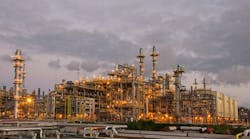With the Atlantic hurricane season now well under way, many in the US are reflecting on last year at this time when one of the largest and costliest hurricanes hit the Gulf Coast region.
Hurricane Katrina ravaged the area and had a devastating impact to the oil and gas industry.
It also illustrated an oil market at work.
The damage
Katrina and Hurricane Rita, which arrived a month later, destroyed or severely damaged platforms and other production facilities in the Gulf of Mexico and idled refineries and gas processing plants onshore. Katrina’s initially shut down 90-95% of the gulf’s daily oil production and 80-85% of its natural gas production.
Two major pipelines that supply oil products from Gulf Coast refineries to the East Coast shut down as well. Flow through another pipeline, which carried crude from the gulf to Midwest refineries, was delayed for several days, lowering gasoline output for that region. And this was just the beginning of the trouble for the pipeline industry. Even with all the damage, however, there were no major spills.
Katrina delivered a direct blow to the hub of the US refining industry. The Gulf Coast region, or Petroleum Administration Defense District 3 (PADD 3), constitutes nearly 47% of the nation’s refining capacity and 36% of the total gasoline that enters the supply stream.
Many of the region’s refiners were still assessing damage from Katrina when Rita came ashore. Ultimately the industry saw a lasting decline in refinery capacity of 10-15%. The damage to onshore gas processing facilities limited gulf gas production.
Market adjustments
With the US at the time already in short supply of gasoline, the sudden loss of gulf crude production and Gulf Coast refining capacity pushed up retail gasoline prices.
OGJ’s weekly gasoline price survey reported that regular unleaded gasoline prices hit $3.05/gal on Sept. 3, 2005, up 37¢ from the previous week. Once refiners slowly started bringing their units back online and taking delivery of increased gasoline imports, prices subsided to prehurricane levels.
On Oct. 12, 2005, OGJ reported prices at $2.61/gal, showing how markets work when allowed to run their courses.
A year later, motor gasoline prices have dropped again. After Hurricane Ernesto was downgraded last week to a tropical storm, prices fell more than 11¢ to $2.98/gal. This is the largest decline in price since Oct. 12, 2005, when prices settled back down after the hurricanes. Posted crude prices from major oil refiners as well as futures prices on the New York Mercantile Exchange fell more than $2/bbl after the announcement that the Gulf Coast region would be spared.
The cheapest gasoline, according to OGJ’s survey, was in Des Moines ($2.62/gal). The Midwest average showed the largest decline in price at $2.82/gal, down 15.6¢ from a week prior. San Diego showed the highest price at $3.22/gal, but even this price was down 9.3¢. Miami was the only city in the survey that posted a price increase for the week, most likely reflecting anticipation of Tropical Storm Ernesto.
In early August, crude prices rose after the initial announcement that BP PLC would be shutting down oil production from Prudhoe Bay field. BP later said the shutdown would be partial. This has slowly led to crude prices dipping below $70/bbl in the last week, further softening gasoline prices.
With signs that the market has gradually stabilized, as well as the US summer driving season coming to a close this weekend, even lower prices at the pump seem likely.
Anyone ready for a road trip?

